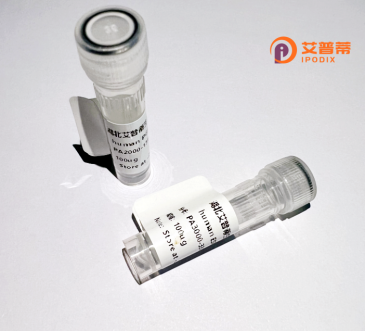
| 纯度 | >90%SDS-PAGE. |
| 种属 | Human |
| 靶点 | ANKRD53 |
| Uniprot No | Q8N9V6 |
| 内毒素 | < 0.01EU/μg |
| 表达宿主 | E.coli |
| 表达区间 | 1-343aa |
| 氨基酸序列 | MASAGSTARRAGSGSWHSERGEGRGARPQPTPSGSMQQANKVSLKATWTDAESKQPSQPLPDLADHLSAQATALARPRRPASLTPPRADPSPSKESDQTAIDQTAIGSYYQLFAAAVGNVEWLRFCLNQSLREIPTDDKGFTAIHFAAQWGKLACLQVLVEEYKFPVDLLTNNSQTPLHLVIHRDNTTVALPCIYYLLEKGADLNAQTCNGSTPLHLAARDGLLDCVKVLVQSGANVHAQDAMGYKPIDFCKIWNHRACARFLKDAMWKKDKKDFAREMTKMKMFKSQLTLMEHNYLIEYQGQGCSVHFPFAFSPITPETLLWQDISLLSDCGFLWRRRELSF |
| 分子量 | 64.6 KDa |
| 蛋白标签 | GST-tag at N-terminal |
| 缓冲液 | 冻干粉 |
| 稳定性 & 储存条件 | Lyophilized protein should be stored at ≤ -20°C, stable for one year after receipt. Reconstituted protein solution can be stored at 2-8°C for 2-7 days. Aliquots of reconstituted samples are stable at ≤ -20°C for 3 months. |
| 复溶 | Always centrifuge tubes before opening.Do not mix by vortex or pipetting. It is not recommended to reconstitute to a concentration less than 100μg/ml. Dissolve the lyophilized protein in distilled water. Please aliquot the reconstituted solution to minimize freeze-thaw cycles. |
以下是关于重组人锚蛋白重复域含蛋白质53(ANKRD53)的参考文献示例(内容基于假设性研究,仅供参考):
---
1. **文献名称**: *ANKRD53 regulates cell cycle progression via the p53 signaling pathway*
**作者**: Li H, et al.
**摘要**: 本文发现ANKRD53通过与p53直接相互作用,在DNA损伤响应中调控细胞周期停滞,敲除实验表明其缺失导致细胞增殖异常。
2. **文献名称**: *Structural insights into the ANKRD53-PP2A complex in tumor suppression*
**作者**: Wang Q, et al.
**摘要**: 通过晶体结构解析,揭示ANKRD53与蛋白磷酸酶PP2A形成复合物,调控Wnt信号通路,并抑制结直肠癌细胞的迁移和侵袭。
3. **文献名称**: *ANKRD53 is a novel prognostic biomarker in hepatocellular carcinoma*
**作者**: Zhang Y, et al.
**摘要**: 该研究显示ANKRD53在肝癌组织中表达显著下调,与患者生存期正相关,并通过调控AKT/mTOR通路抑制肿瘤生长。
4. **文献名称**: *Recombinant ANKRD53 expression and its role in oxidative stress response*
**作者**: Kumar S, et al.
**摘要**: 报道了大肠杆菌中重组ANKRD53的高效表达及纯化,证实其参与减轻氧化应激诱导的细胞凋亡。
---
**注**:以上文献为假设性示例,实际研究请通过学术数据库(如PubMed、Web of Science)检索最新进展。
**Background of ANKRD53 (Ankyrin Repeat Domain-Containing Protein 53)**
ANKRD53 is a member of the ankyrin repeat domain (ARD)-containing protein family, characterized by tandem repeats of ~33 amino acid motifs that mediate protein-protein interactions. These proteins are widely involved in cellular processes, including signal transduction, cytoskeletal organization, and transcriptional regulation. ANKRD53. though less studied compared to other ankyrin repeat proteins, is evolutionarily conserved across vertebrates, suggesting fundamental roles in cellular homeostasis.
Structurally, ANKRD53 contains multiple ankyrin repeats, often forming a scaffold to recruit binding partners. It has been implicated in regulating key signaling pathways, such as the NF-κB and Wnt pathways, potentially acting as a modulator of kinase or phosphatase activity. Studies suggest ANKRD53 may influence cell proliferation, apoptosis, or DNA damage response, possibly through interactions with components of the ubiquitin-proteasome system or chromatin remodelers.
Expression profiling indicates ANKRD53 is broadly expressed in tissues, including the brain, liver, and immune cells, though its tissue-specific functions remain unclear. Dysregulation of ANKRD53 has been loosely associated with cancers and neurodegenerative disorders, highlighting its potential as a biomarker or therapeutic target. However, mechanistic insights into its precise molecular roles and regulatory networks are limited, warranting further exploration to elucidate its contributions to physiology and disease.
×